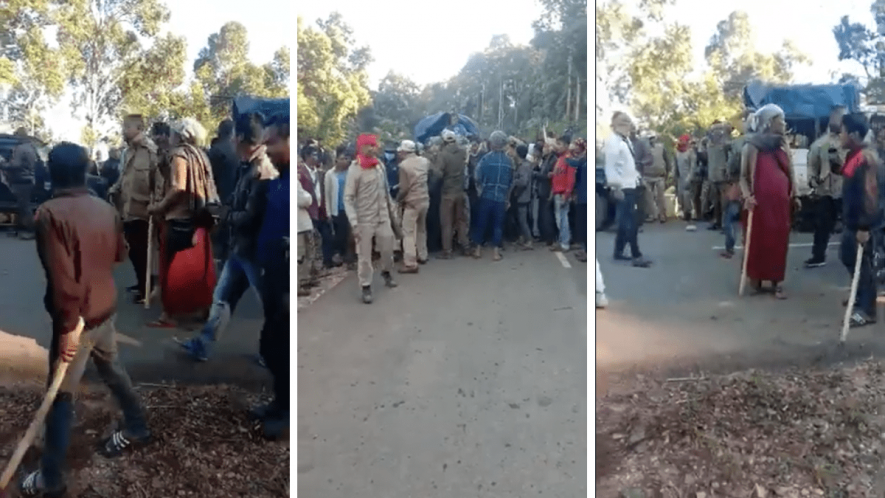Mukroh Killings: Are Fault Lines Widening in Assam-Meghalaya Border?

Image Source: EastMojo, used for representation only.
Guwahati: Mukroh is a village in North-East India and has been in the news due to the unfortunate incident where six persons were killed on November 22, early in the morning. A tense situation prevails not only in Mukroh but many other places along the Assam-Meghalaya border. Mobile internet services have been shut down in seven districts of Meghalaya for 48 hours since the day the incident occurred.
The Meghalaya government’s official website refers Mukroh as a village in the West Jaintia Hills under the Laskein block. In a question asked about whether Mukroh was a disputed area of Assam-Meghalaya border, Meghalaya Chief Minister Conrad Sangma said at press conference that there was absolutely no dispute regarding the village and that the incident very much happened inside Meghalaya.
However, there have been reports terming Mukroh as a ‘disputed’ area, belonging to the West Karbi Anglong district of Assam. This view is also reflected in statements made by the Assam Police and other state government officials, and of course, is a common perception, too.
It is worth mentioning here that Assam shares loose borders with several neighbouring states and there have been numerous incidents of violence in these areas.
Newsclick spoke with some police officials posted in the West Karbi Anglong district on the issue. A police officer, who had earlier served in the district in the rank of additional SP (superintendent of police) said border areas have always seen smuggling activities, such as of timber and coal.
Giving a first-hand account of what happened on November 22, circle inspector (CI), Jiyaur Rahman Khan, told Newsclick: “On that day, the forest ranger chased a truck full of timber, which was supposedly illegal. The team comprised forest guards and Assam Police personnel. At Mukroh, at around 3 or 4 o clock in the morning, the truck was stopped. Soon the villagers gathered and the crowd swelled within a short while. The Assam Police opened fire as retaliation.”
Khan has Jirikinding, Baithalangso and Kheroni police stations within his jurisprudence.
This has been the version of the police and as also of the Chief Ministers of Assam and Meghalaya regarding the killing of six persons, including one Assam forest guard. Notably the other five deceased were the villagers of Mukroh.
Sangma in the same press conference alleged that Assam Police resorted to ‘unprovoked’ firing, which was also indicated by Assam Chief Minister Himanta Biswa Sarma, who in a statement said the Assam Police could have exercised more restraint and the firing was unprovoked.
However, there is something more to add to the police version. Noted journalist and social activist Patricia Mukhim, in a telephonic conversation with Newsclick, said that reports of police pursuing the timber-loaded truck by the Assam forest guard along with Assam Police were true.
“However, in the process, the team also rounded up three villagers when they entered Mukroh. This news spread in the village and people got agitated,” she said.
Mukhim said these villagers had gone to the forest like they usually do. Due to their detention by the police and forest guards, the villagers gathered there in large numbers within a few minutes. “There might have been panic firing by the police”, she said. What Mukhim said was also shared by some other villagers on the spot.
WAS TENSION BREWING FOR SOMETIME IN THE AREA?
Earlier this year, five village heads, including that of Mukroh, had raised some concerns and had urged Sangma to intervene in the border issue. They, along with the local MLA, even met the Chief Minister and urged him to stop encroachment by Assam in the West Jaintia Hills districts. The main point of contention was construction of a police outpost at Saba in West Jaintia Hills district. They perceived the construction as an “illegal activity”. The MLA, Nujorki Sungoh, in a statement to new website EastMojo said the outpost was just 20 minutes away from Saba and it was not in the disputed area, but well within Meghalaya.
Sangma, too, mentioned this in his press conference. He said that Meghalaya Police was present at the spot, but the force was not as large as its Assam counterpart. The Chief Minister also mentioned that the area sanctioned by Meghalaya to build the outpost at Barato (nearby village of Mukroh) was done keeping in view the kind of tension always prevailing in the area. The outpost was supposed to be inaugurated this month and before that happened, this unfortunate incident has occurred, said Sangma.
Till the time this article was written, there is no statement from either Sarma or DGP Assam on this matter. But, Assam Police said that the timber was being transported from the Assam side to Meghalaya and hence the team along with forest guards tried to apprehend it.
ROOT OF DISPUTE LIES IN COLONIAL PERIOD?
The border disputes in the NE region can be traced back to the way the British colonial regime demarcated the areas based only on their administrative convenience. Speaking in this, Antora Borah, assistant professor in the OKD Institute of Social Change and Development, Guwahati, told NewsClick: “It is not unknown that this approach is predicated on the yardsticks often fixed arbitrarily by the colonial regime in order to serve the colonial economic-administrative imperatives and pursued and perpetuated by the post-colonial Indian state."
“Unfortunately, there is a strong proclivity to address and resolve the border issue exclusively on the basis of a juridico-administrative approach. One, therefore, wonders how the tangled border issue with a complex socio-historical and political background could be solved by resorting to mere legal provisions. This inability of the government and various commissions appointed by it from time to time to find an amicable settlement to the border issue is ample testimony to the futility of the legalistic approach. In the backdrop of that it seems a tall order to expect the ongoing local boundary commission to offer a final answer to the problem,” she added.
It is worth mentioning here that Union Home Minister Amit Shah, earlier this year, made lofty claims about the Assam-Meghalaya border issues. He claimed that 70% of the disputes had been resolved as the two states had signed a pact. Also, it is important to remember that disputes and clashes along the border near the Mukroh area are not heard so frequently.
Kyrsoibor Pyrtuh, a civil rights activist based in Meghalaya, providing insights about the past, told NewsClick that the major problem regarding the Assam-Maghalaya border arose in 1951 when the United Mikir and North Cachar Hills district was formed.
“The contention at that time was due to the fact that with the new district in place, some Khasi (and Jaintia) villages became part of it. The newly formed district was in the Assam side and the Khasi people believed their lands are in Meghalaya. Notably, a district was formed by the Britishers, named the United Khasi and Jaintia Hills district, and the erstwhile regime demarcated the areas in 1876 based on their administrative convenience. Some people have never accepted the 1876 demarcations,” he said.
According to Pyrtuh, discontent with the colonial demarcation reflected in 1884 in the forms of disputes. The 1876 colonial notification upset the people as villages inhabited by Khasi people could have fallen in Assam. Pyrtuh said those roots have never been uprooted in the post-colonial period until now. Pyrtuh belongs to the people’s group named Thma U Rangli-Juki.
However, Holiram Terang of Karbi Anglong, who is also former Assam irrigation minister, was a little circumspect about the history. According to him, in 1969, when Meghalaya became an autonomous state, the demarcation of villages was done during the formation of the United Mikir and North Cachar Hills district in 1951.
“There was no conflict,” Terang said. Notably, Meghalaya became a full-fledged state in 1972. However, he agrees that the colonial past is the root cause of the border disputes in the NE region, especially with Assam.
WIDENING FAULT LINES?
Settling inter-state border issues in NE will never be easy. Mere amendments and forming new commissions will not make the path smooth either, which Amit Shah must keep in mind before making hyped claims about dispute settlements.
“Moreover, ignoring the region’s complex history and people not being taken into confidence before any demarcation is laid, will not only be a futile exercise, but also a dangerous one in future,” warns Santanu Borthakur, a noted lawyer in Assam.
“The current incident will further widen the fault lines, a feeling of sort of enmity amongst people from either side is likely to increase with such incidents”, he told NewsClick.
What Borthakur said can be gauged from the incident when a car with Assam registration was set ablaze in Shillong. The taxi driver escaped narrowly as an angry mob in Shillong attacked him, while in Guwahati some people assaulted a Meghalaya taxi driver.
“The media should act responsibly while reporting, that is my only request, the situation is fragile and it takes just a second to make fear and hatred go viral among people”, cautioned Alankar Kaushik, Assistant Professor, EFL University, Shillong.
Get the latest reports & analysis with people's perspective on Protests, movements & deep analytical videos, discussions of the current affairs in your Telegram app. Subscribe to NewsClick's Telegram channel & get Real-Time updates on stories, as they get published on our website.















